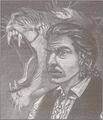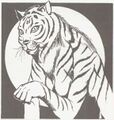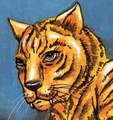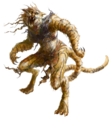Weretiger: Difference between revisions
1d4chan>Nubnuber (→Gallery: added images from RM3) |
1d4chan>Nubnuber |
||
| Line 30: | Line 30: | ||
Weretiger RM3 3.jpg | Weretiger RM3 3.jpg | ||
Weretiger RM3 4.jpg | Weretiger RM3 4.jpg | ||
Weretiger CotN Werebeasts 1.jpg | |||
Weretiger CotN Werebeasts 2.jpg | |||
Weretiger Dragon 93 cover.jpg|Dragon #93 | Weretiger Dragon 93 cover.jpg|Dragon #93 | ||
Weretiger GH2.jpg|Grim Harvest 2: Death Ascendant | Weretiger GH2.jpg|Grim Harvest 2: Death Ascendant | ||
Revision as of 21:25, 18 August 2022
 | This article or section is about Monstergirls (or a monster that is frequently depicted as a Monstergirl), something that /tg/ widely considers to be the purest form of awesome. Expect PROMOTIONS! and /d/elight in equal measure, often with drawfaggotry or writefaggotry to match. |


Weretigers are one of the "core" groups of therianthrope in Dungeons & Dragons, having appeared in multiple editions and generally being the first of the feline therianthropes to be converted for their edition. They have a patron goddess called Ferrix, whose only appearance to date was in Monster Mythology; thusly, we know very little beyond the fact she exists. In Advanced Dungeons & Dragons, they were a predominantly female race, albeit not exclusively female like the werefox, but they lost that trait as editions advanced.
In their original AD&D lore, it's established that weretigers are able to assume three forms; their initial form, a tiger form, and a hybrid form that looks more like a catgirl than a catfolk... no, seriously! This is word-for-word the description of their hybrid form in the Monstrous Manual:
- The weretiger form is a hybrid between a human and a tiger. It is about 25% larger than the human form, and is covered by tiger-striped hide. A 3-foot tail extends from the spine. The legs are more feline than human; this form walks on its toes. The head is also a mixture of features. The ears, nose, muzzle, and teeth are tigerlike, but the eyes and overall shape are human. If the human form’s hair is long, it is still present. The fingernails grow into claws. Despite the changes, the hybrid form can pass for human at a distance if properly disguised.
A weretiger in its human form is usually a woman with a "sleekly muscular" build, greater than average height, and noticeably high agility - ion fact, weretigresses outnumber the male weretigers at a ratio of 5 females to 1 male. The voices of weretigers are husky and they tend to roll their r’s. Weretigers possess formidable strength, a heightened sense of smell and keen nightvision, and these traits even remain in their human form; weretigers are often masters in the art of unarmed combat, and employ it to deadly effect in both human and hybrid form, with the latter adding lethal slashing claws to the mix. Biting is seen as gauche, and typically reserved for when a weretiger is forced to fight in its tiger form.
As the de-facto Werecat of D&D, weretigers are given a preternatural form of feline charisma; they can speak to any cat, and are supernaturally charming towards all normal cats with the exception of regular tigers, who very rarely want to hang around with them, but even other feline monsters are more inclined to be chuimmy than not. In AD&D, this mechanically manifested as weretigers having a 75% chance to be accompanied by a regular feline of some kind (which was then 5% chance of a tiger, 95% chance of something else, like a lion or a leopard), and 25% chance to be accompanied by some kind of feline monster, like a Displacer Beast.
Weretigers are omnivores who typically maintain small, well-kept cabins on the outskirts of human civilization, giving them easy access to both the wilderness to hunt and the conveniences of society - namely shopping. Such cabins typically house either a lone wereiger or a small pride, and serves as the epicenter of a 7-10 square mile radius territory. The cabin usually has a small garden full of herbs and vegetables, as well as an abundance of resident cats, but no livestock except maybe assorted poultry kept for their meat and eggs - weretigers go hunting and fishing for meatier fare. Weretigers often are well aware of nearby ruins or dungeons, and have a fondness for gems, which are typically cached inside of or at least close to their cabin, along with any other treasures acquired from wherever.
To reproduce without passing on their therianthropy, weretigers can breed with both humans and tigers; the children of a male weretiger appear to be ordinary individuals of the mother's race, until they reach adolescence and spontaneously develop their transformation ability. Weretigresses, however, give birth to one or two cubs who are born in the hybrid form, thus resembling fuzzy human babies with tails. These cubs mature with incredible speed, closer to a tiger than a human; they can crawl within days, walk within a month, and hunt within a year, with their human-like appearance and size matching that of a human child thrice their actual age. These weretiger cubs reach adolescence at age six, gaining the ability to assume their human form, and finally adulthood at age twelve, which is when they gain the ability to become tigers.
Jungle Giants are known to be susceptible to any therianthropic strain found in the jungles, but are stated to be particularly vulnerable to feline therianthropy, which means that they have an abundance of weretigers in their ranks.
Gallery
-
1e
-
PC4
-
-
AD&D Monster Card
-
Monstrous Compendium: Ravenloft
-
Monstrous Compendium Vol. 1
-
-
-
-
-
-
-
-
Dragon #93
-
Grim Harvest 2: Death Ascendant
-
3e
-
4e
-
Pathfinder
-
| The Therianthropes of Dungeons & Dragons | |
|---|---|
| Therianthrope | Laridian • Loup-garou • Loup du Noir • Lythari • Red Falcon • Seawolf • Selkie • Shifter • Swanmay • Thebestyn • Vodoni • Werebaboon • Werebadger • Werebat • Werebear • Wereboar • Werecat • Werecrocodile • Werefox • Werehyena • Werejackal • Werejaguar • Werekillerwhale • Wereleopard • Werelion • Werepanther • Wererat • Wereraven • Wereray • Wereseal • Weresnake • Wereshark • Werespider • Wereswine • Weretiger • Werewalrus • Werewolf |
| Antherions | Aranea • Song Dragon • Jackalwere • Nawidnehr • Wolfwere |
| Third Party | Werealligator • Wereanaconda • Werebunny • Werecheetah • Werecobra • Weremustela • Wereoctopus • Werepossum • Wereraccoon • Werestag • Werewolverine |
















